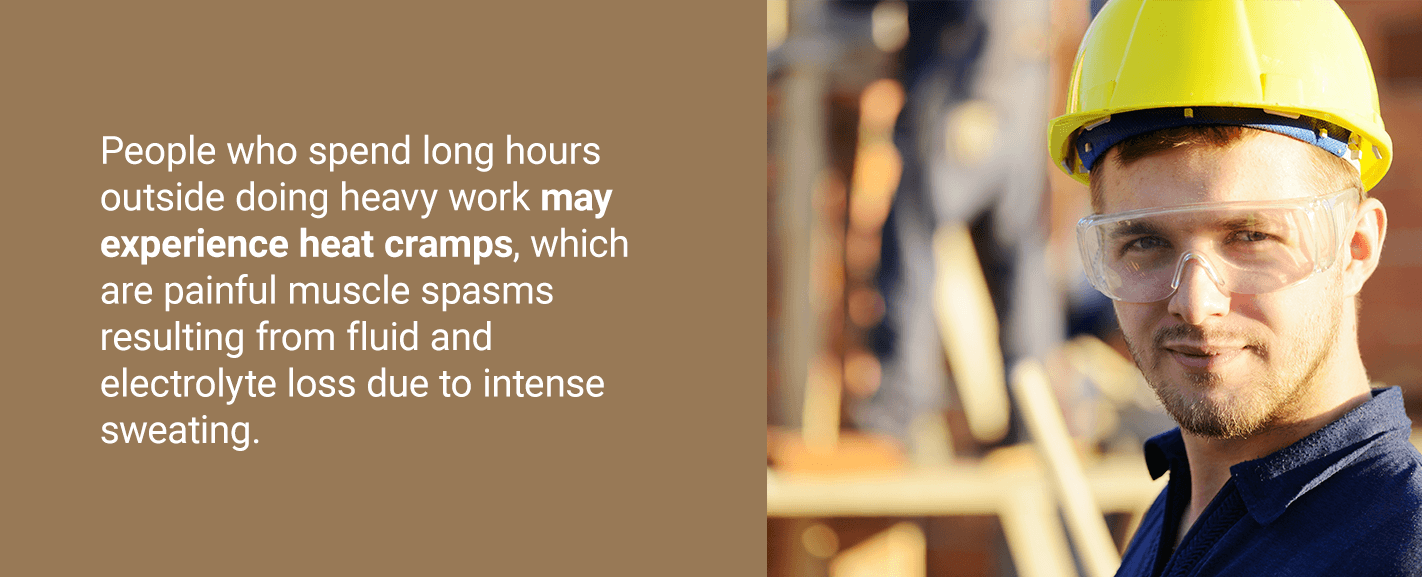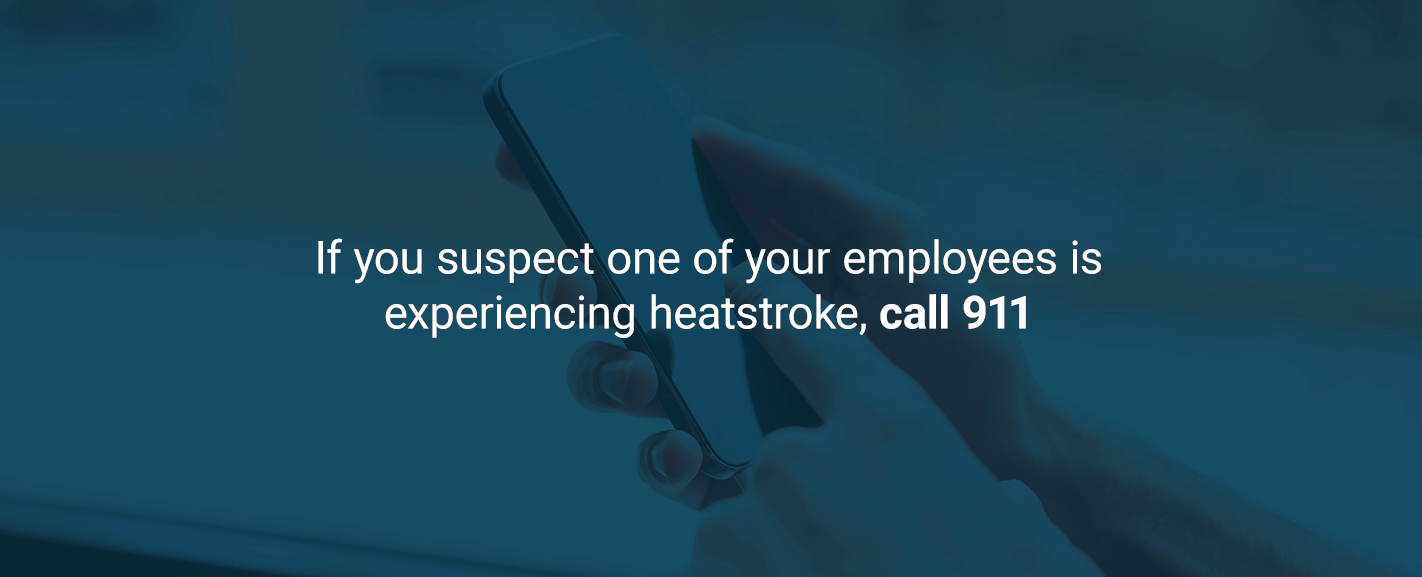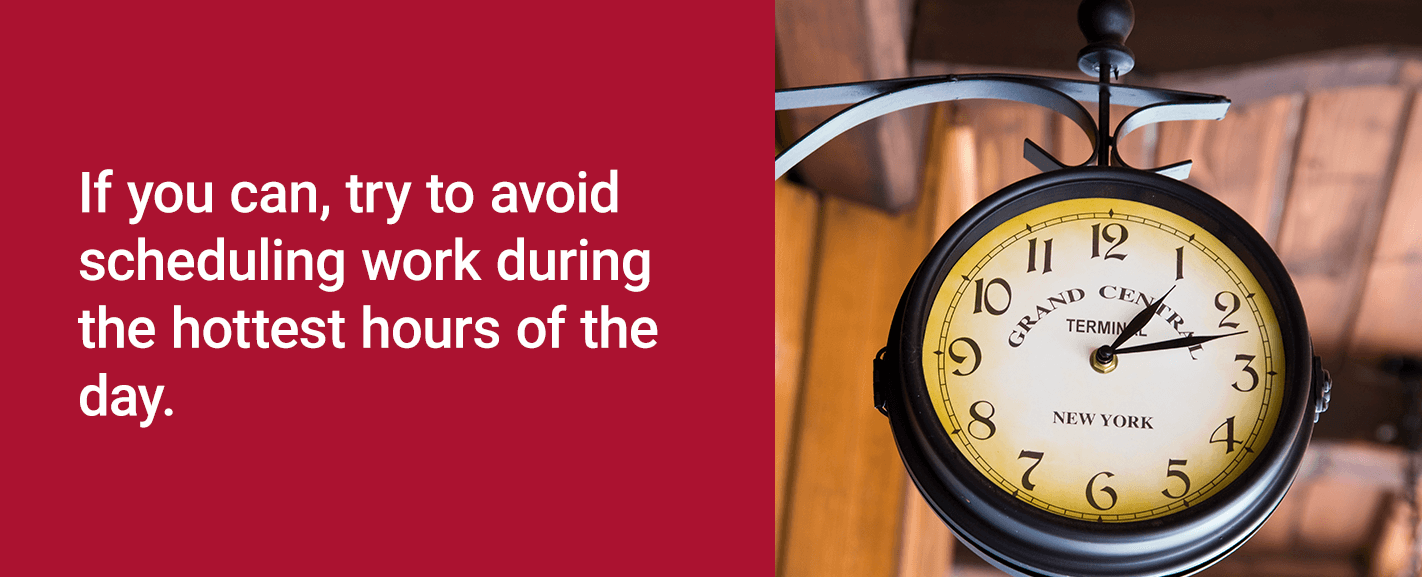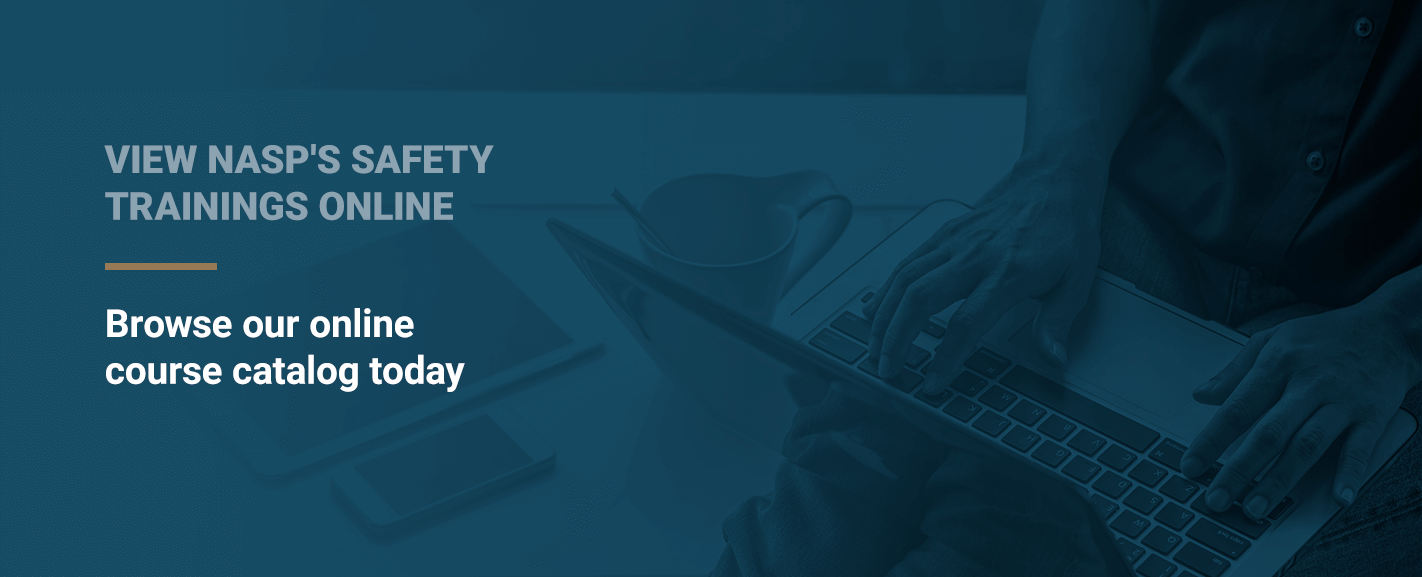Precautions for Summer Job Site Safety
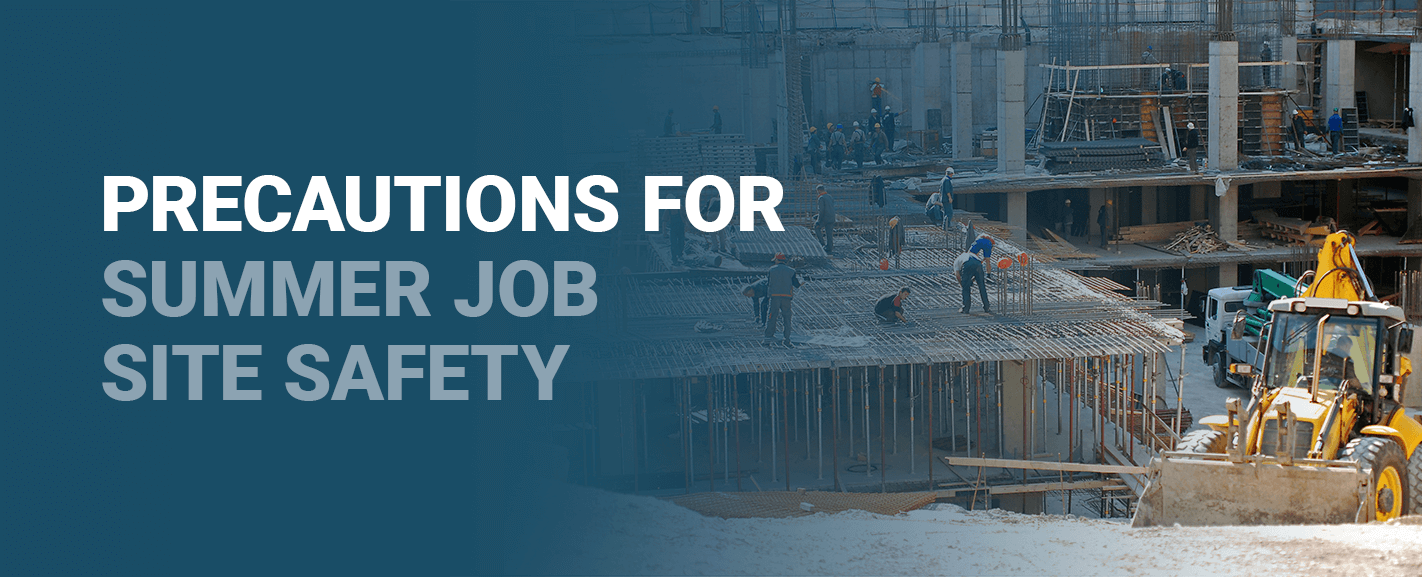
According to a University of California Los Angeles study, hot weather increases the risk of work-related accidents and injuries across many industries. This risk is exceptionally high in the construction industry, where workers are often continuously active in direct sunlight for long hours.
Fortunately, employers can reduce accidents and injuries by taking precautions for summer job sites. Learn more about how to prevent job site accidents in the summer below.
View Our Certified Safety Manager: Construction Course
The Risks of Working in Summer Heat
For many construction companies, summer is the perfect season to get to work. But for workers in warm climates, the scorching summer sun can pose a grave health threat. Common risks construction workers face include:
- Sunburn: Unprotected exposure to ultraviolet (UV) light can cause painful sunburns, leading to an increased risk of skin cancer or other related issues.
- Dehydration: Inadequate hydration can lead to severe mental and physical consequences. Signs of dehydration include dark or infrequent urination, extreme thirst, fatigue, dizziness, or confusion.
- Heat illness: Heat illness sets in when the body overheats to the point where it can no longer cool itself. It can be fatal if left untreated.
Supervisors, managers, and employees should always look for teammates showing signs of heat illness. If someone seems to be suffering, you need to act immediately to save their life.
1. Heat Cramps

People who spend long hours outside doing heavy work may experience heat cramps, which are painful muscle spasms resulting from fluid and electrolyte loss due to intense sweating. While heat cramps can occur in any part of the body, heat cramps usually affect the following muscle groups:
- Calves
- Arms
- Abdominal wall
- Back
If one of your employees is experiencing heat cramps, take them out of the heat right away and give them water or a carbohydrate-electrolyte replacement beverage. Allow them to rest and cool down and encourage them to practice gentle stretching and massage the muscle. Keep them off the job site for several hours after the cramping has subsided to ensure recovery.
2. Heat Exhaustion
Heat exhaustion is essentially the first stage of heatstroke. It’s the point when your body begins to overheat and have trouble cooling itself down.
Signs and symptoms include:
- Fainting or dizziness
- Abnormal fatigue
- Nausea
- Headaches
- Low blood pressure
- Increased sweating
- Muscle cramps
- A rapid, weak heartbeat
You should always treat heat exhaustion seriously. If a team member seems to be exhibiting symptoms, get them out of the heat immediately and allow them to cool down. Dismissing their condition could lead to heatstroke and potentially severe consequences.
3. Heatstroke
Heatstroke happens when your body reaches a core temperature of 104 degrees Fahrenheit. At this point, you’re overheating, and your body is unable to cool itself down like it usually would.
Signs of heatstroke include:
- Confusion, agitation, or delirium
- Irrational behavior
- Heavy sweating
- Headaches
- Vomiting and nausea
- Rapid heart rate
- Red skin
- Fainting
If you suspect one of your employees is experiencing heatstroke, call 911 immediately. Then, move the team member out of the heat and cool them down by applying ice or cold water to their skin. Provide them with cool water if they’re conscious to rehydrate them.
Tips for Summer Job Site Safety
Construction industry veterans know that the best way to prevent disaster is to reduce or eliminate hazards wherever possible. Implementing proactive safety precautions for your job site is especially crucial during the summer because effective planning can significantly reduce your organization’s risk of heat-related incidents.
Here are some of our top tips for protecting your workers against rising temperatures:
1. Educate Your Team
Taking the time to thoroughly explain the dangers of heat-related illness can help drive home the importance of taking care of yourself while on the job. This education should cover the risks of working in the heat and summer job site precautions employees can take to protect themselves from the heat.
There’s a variety of ways you can raise awareness in your staff:
- Require heat illness training for new hires.
- Issue a company-wide warning at the start of the season.
- Send out reminders on especially hot days.
The method you choose depends on what works for your company, but keeping your staff informed is crucial to the success of any safety plan.
2. Create a Summer Dress Code
Your employees should always wear clothing and personal protective equipment (PPE) that meets safety regulations. However, bulky garments can contribute to the risk of heat illness. Employees should avoid dark, heavy materials wherever possible and opt for the following instead:
- Light colors: Light-colored or white clothing reflects sunlight, which keeps you cooler.
- Natural materials: Materials like cotton and linen are naturally lightweight and sweat-wicking, which keeps you cool and comfortable. Avoid heavy synthetic materials whenever possible — they trap heat close to the skin, which can be dangerous in high temperatures.
- Mesh: Mesh is highly breathable and sweat-wicking, making it an excellent choice for top layers and safety vests.
- Built-in ventilation: Vented shirts allow maximum breathability and comfort.
Some companies have created specialty gear that fulfills safety requirements while still providing relief from the intense summer heat. While these pieces can be pricey, increasing your employees’ comfort levels is worth the cost. Here are a few examples:
- Hard hat sweatbands: These bands are designed specifically to be worn under a hard hat, where they can absorb sweat and provide an extra layer of heat protection. You can even freeze them to keep you cooler for longer.
- Wide-brim hard hats: Standard hard hats are great for cool weather, but they do little to protect your skin from the sun. Hard hats with fuller brims give your face and neck extra coverage.
- Nape protectors: These inserts are like curtains that hang down from the back of your hard hat to shield the back of your neck from the sun, which can keep your whole body slightly cooler.
- High-visibility reflective garments: Light, breathable, reflective clothing repels sunlight and makes your team members more visible to their coworkers and pedestrians.
3. Promote Healthy Habits
Fit, nourished, and well-rested people are better able to withstand the summer heat than sedentary people with poor diets. Healthy meals, hydration, and plenty of rest are important factors for staying sharp and focused while on the job.
One way to encourage employees to take care of their bodies is to implement a stretch and flex program, which can help prevent work-related injuries. Short exercise breaks throughout the day can help loosen workers’ muscles and increase alertness, which reduces the risk of injury.
If you can, consult with a professional physiotherapist or trainer to develop a program that activates important muscles and can improve mobility for every worker.
4. Encourage Frequent Breaks
Make sure your managers and team members are taking breaks from the heat. Provide your staff with a designated shaded area or an indoor space for taking breaks. Make sure you have water available, as well.
Efficient scheduling will allow team members to take sufficient breaks without interrupting your operation’s workflow. Overlapping breaks and shifts is a great way to ensure someone is always working on each task.
5. Emphasize Hydration
Many adults don’t feel thirsty until they’re already dehydrated, so making sure your staff drinks enough water is crucial. Check that your employees always have water available to them and encourage them to drink at least every hour instead of only when they feel thirsty.
Encourage workers to keep water bottles within reach whenever possible. Sports drinks with electrolytes can also be beneficial since electrolytes work to maintain hydration. However, it would be best if you steered clear of sugary or caffeinated beverages like soda, lemonade, or energy drinks — soft drinks can actually increase the risk of dehydration.
Additionally, water-rich fruits and vegetables can help boost hydration levels — for that reason, encouraging healthy eating habits among your team can help reduce the risk of heatstroke. Some examples include:
- Cucumbers
- Strawberries
- Zucchini
- Melons
- Lettuce
- Bell peppers
- Celery
- Peaches
One easy way to make sure you’re hydrated is to check the color of your urine — light to bright yellow is a good sign, while dark orange is an indicator of dehydration. If you find that your urine is dark, drink more water and keep an eye on how you’re feeling. If you begin to experience any symptoms of heat illness, get out of the heat and tell someone.
6. Schedule Work Around the Heat
If you can, try to avoid scheduling work during the hottest hours of the day. The sun is usually strongest at midday, when it’s highest in the sky. However, this time can vary depending on your location.
Here are some scheduling suggestions to beat the heat:
- Start work early in the morning.
- Start work later and work into the evening when the sun goes down.
- Schedule indoor tasks or a long midday break.
If you absolutely must work during this time of day, try to schedule more frequent breaks to get your staff out of the heat as often as possible.
Purchase Our Certified Safety Manager: Construction Course
OSHA Safety Tips for Summer Heat
OSHA launched its heat illness campaign in 2011 to educate employers and workers about the dangers of working in the heat. One of the key elements of the campaign is establishing a comprehensive heat illness prevention program to reduce the risk of heat-related incidents on the job.
A heat illness prevention program can help you be proactive in keeping your employees safe. Designate someone trained in heat-illness-related hazards to develop, implement and oversee the program.
Good prevention programs should include:
- Provide water, rest, and shade: By making shaded areas, water, and frequent breaks available to your staff, you significantly reduce your team’s risk of experiencing heat illness. OSHA mandates that employers supply their employees with water as soon as the heat index rises above 103 degrees Fahrenheit. Of course, it’s best to provide water when temperatures hit higher than the 70s, as well.
- Allow workers to acclimatize: According to OSHA, almost three out of four heat illness fatalities occur during the first week of work. Let your employees build up a tolerance to the heat by gradually increasing work intensity by about 20% each day.
- Plan for emergencies: Create a documented plan outlining what to do when a worker experiences heat illness. Train your team on the finalized plan and make a hard copy available on your job site in case anyone needs to refer to it.
- Check on your employees: In addition to visually monitoring the team, managers and supervisors should conduct verbal check-ins at frequent intervals, especially if workers are wearing face coverings. Encourage employees to do the same to each other if they notice something is off.
- Know when it’s too hot: In addition to a standard thermometer, using an on-site wet bulb globe temperature (WBGT) meter can deliver the most accurate reading of heat stress on your workers. The risk will vary depending on whether your worker has fully acclimatized, but a reading above 77 degrees Fahrenheit is too hot for anyone to work.
Benefits of Safety Precautions for Summer Job Sites
The most obvious benefit to taking safety precautions in summer is the safety and health of your workers. But did you know that investing in safety programming can also benefit your organization? According to a 2017 study, workplace safety is one of the top criteria employees consider when evaluating job offers.
There are many other benefits to investing in safety campaigns:
- Employees who feel that their employers value their well-being are more engaged and productive.
- More employees apply to work for organizations that make a visible commitment to workplace safety.
- In general, employees prefer workplace well-being to material perks and benefits.
- Employees who feel that their safety is valued are less likely to engage in unsafe acts or cut corners.
- Companies that prioritize safety experience much lower turnover rates than those where safety is an afterthought.
The key to obtaining these benefits is a strong safety culture. The term “safety culture” refers to an organization’s attitudes and behaviors towards safety in the workplace. Without a positive safety culture, implementing safety programming can be challenging.
Building a strong safety culture relies on several factors, including:
- Leadership demonstrates zero tolerance for unsafe behaviors.
- Staff and leaders prioritize transparency, accountability, and respect.
- Employees can report errors and unsafe behaviors without fear of retaliation.
- Employees are proactive in eliminating hazards before they become problems.
- The organization aims to learn from accidents and use that information to improve continuously.
- Employees look out for each other and ensure they’re following safety protocols.
- The employer provides training to ensure all team members are on the same page regarding safety.
You can get started developing your organization’s safety culture by taking the time to learn more about safety programming.
View NASP’s Safety Trainings Online
As a safety professional in the construction industry, you know the importance of risk education. Investing in a training course from the National Association of Safety Professionals (NASP) can help you learn to exceed OSHA standards.
At NASP, we feel justified in calling ourselves innovators in professional safety education. Our cutting-edge NASP Method of EHS Training, which creates an engaging, dynamic training experience that ensures knowledge retention.
Our courses are developed by safety professionals for safety professionals — as a result, we made sure to meet or exceed OSHA regulations in every aspect of our training. Browse our online course catalog, or click here to see what in-person courses are being offered near you.
Related Posts


